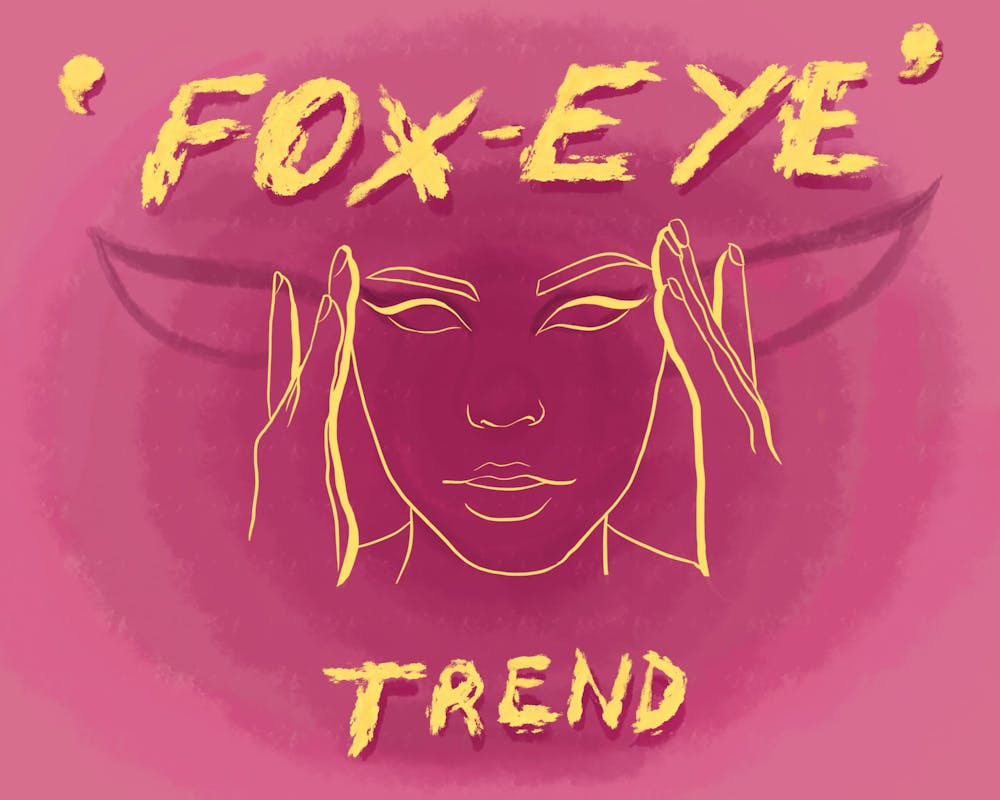Eyes have always been a sensitive topic for many Asians in America, no matter their ethnicity. From being subject to “ching–chong” chants or the common gesture of pulling up eye corners to mimic “looking Chinese,” the natural slant of Asian eyes has forever been a target of racism. TV personality Julie Chen got cosmetic eye surgery because she was told she would not succeed unless she made her “eyes look bigger.” Civil rights activist Fred Korematsu attempted to go to a plastic surgeon to change his eyes in hopes of preventing him from being sent to a Japanese internment camp. Yet despite Asian eyes being a source of trauma for many, they are now considered a fashion “trend.”
The fox–eye trend began with a combination of eyeliner, eyeshadow, and false eyelashes that created an almond eye shape. It can also include shaving off the tails of eyebrows and elongating the inner corners of the eyes to create a more slanted shape. On top of this new makeup look, influencers started the trend of the “migraine pose,” a pose that looks incredibly similar to how people pulled back their eyes to taunt Asians.
While fox–eye makeup itself can be seen as “an exaggerated variation of the wing–tip liner,” its combination with the migraine pose crosses into an insensitive form of cultural appropriation that makes light of Asian stereotypes.
On influencers like Kendall Jenner, Bella Hadid, and Emma Chamberlain, this manufactured, slanted eye look is considered “beautiful,” “trendy,” and “exotic.” Yet on Asians, who have naturally slanted eyes, it’s considered “ugly” and an object of either ridicule or fetishization. Despite the painful history associated with Asian eyes, influencers have continued to co–opt and “colonize” them. They have made Asian eyes their momentary trend and have ignored the racist actions that often target them.
While Emma Chamberlain, who has been rightfully called out for her adoption of this offensive trend, claimed that it “was NOT [her] intention at all and [she’s] so sorry to those who were hurt by it,” the fox–eye trend is still incredibly prevalent throughout social media and influencer culture due to a combination of lack of education, intentional ignorance, and outright racism.
Despite massive backlash from the Asian community and many opportunities for education, celebrities continue to use the fox–eye trend as a way to exoticize themselves. While some may argue that the trend is one that is complimentary to East Asians and reflects an admiration for diverse features, this argument completely dismisses the trauma that many East Asians have had to deal with that targeted the natural slant of their eyes. Similarly, others justify the fox–eye trend by emphasizing that American beauty standards are evolving with America’s growing diversity. However, these ethnic features seem to only be considered beautiful on white people, highlighting exactly what is wrong with many fashion “trends” today.
From the emasculation of Asian men to the common phrase “good–looking, for an Asian” (it always has to include that qualifier), Asian beauty clearly has been undermined in American culture. Yet, at the same time, the fox–eye trend and the proud occurrence of “yellow fever” show a sense of contradictory exoticization. These juxtaposing treatments of Asian beauty dehumanize an entire race and draw attention to how Asian people will always be considered “other” in white America. It further contributes to the continued subtle perpetuation of imperialism and colonization of Asian communities and serves to objectify and demean.
Quite simply put, the fox–eye trend is not a celebration of Asian culture. Asian eyes are not an aesthetic or a trend. They hold centuries of trauma, pain, and degradation that the Asian–American community has had to face throughout every step of life. If you’re looking to pull your eyes back to look “exotic” or “sexy,” don’t.







